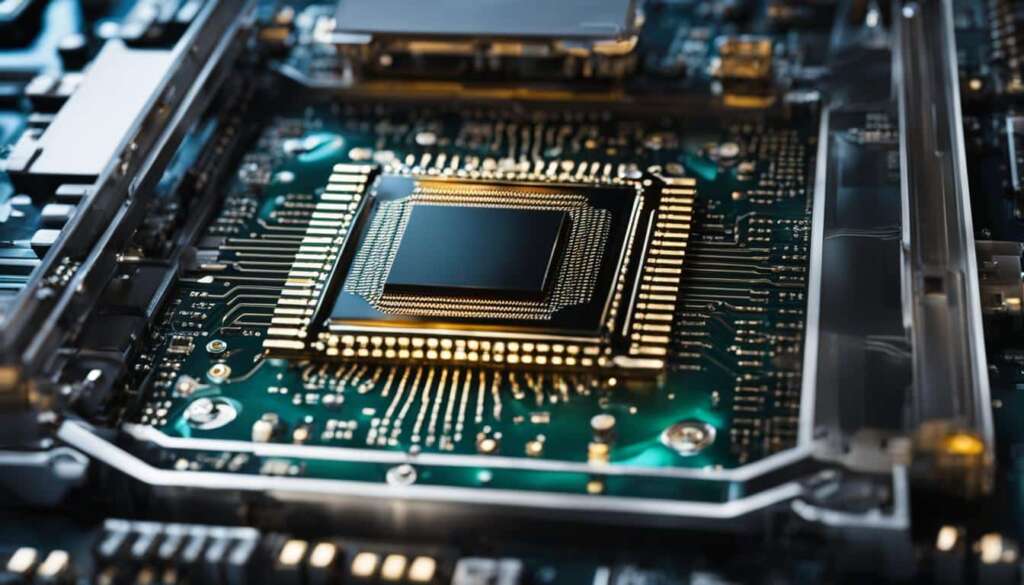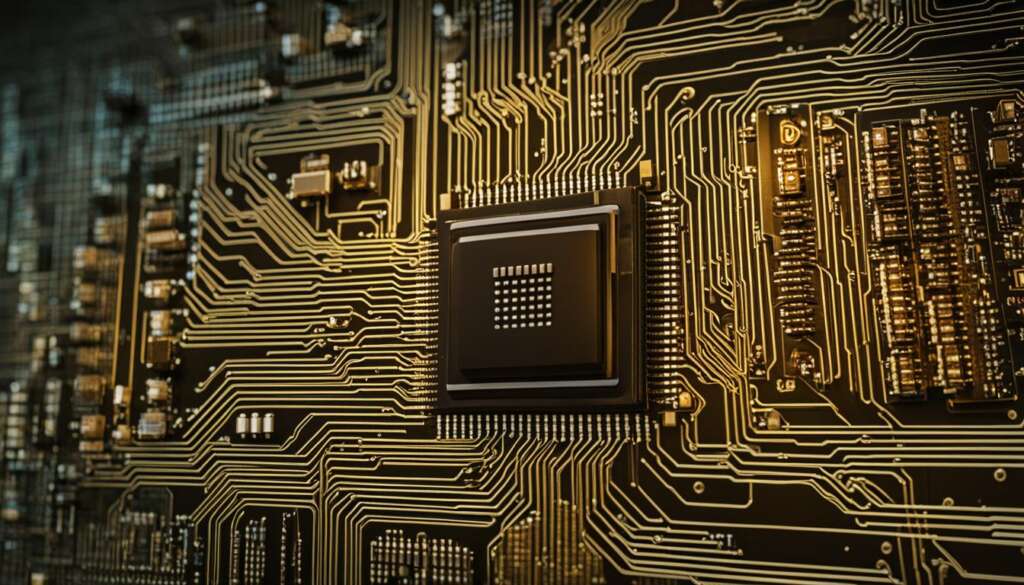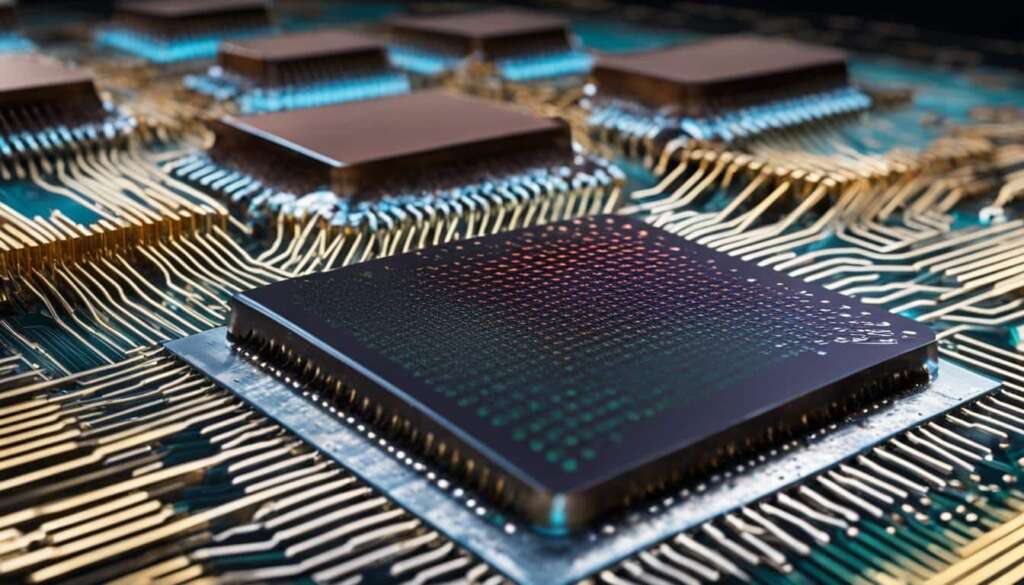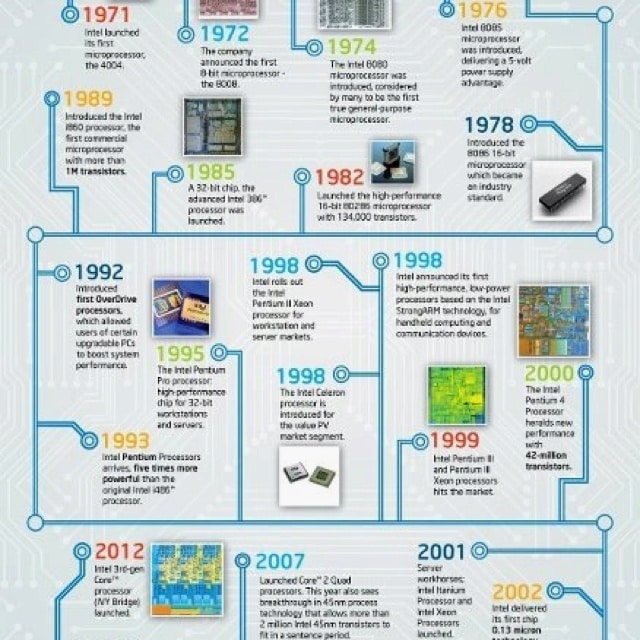Table of Contents
The evolution of processors is a fascinating tale of innovation and growth in the semiconductor industry. From the early stages of processor development to the constant advancements in CPU technology, this journey has shaped the digital landscape we know today. Join us as we delve into the historical overview of processor evolution, highlighting key milestones and innovations that have propelled the industry forward.
Key Takeaways
- Processor evolution has driven the growth of the semiconductor industry.
- The historical overview showcases the advancements in CPU technology.
- Key milestones have shaped the digital landscape we know today.
- Processor development is an ongoing journey with limitless possibilities.
- Technological innovation and ethical considerations will shape the future of processors.
Dawn of Digital Computing: The Vacuum Tubes and Relays Era (1930s – 1950s)
The early era of computer processors was dominated by vacuum tubes and relays, marking the dawn of digital computing. The introduction of machines like the Electronic Numerical Integrator and Computer (ENIAC) showcased the potential of large-scale electronic computing. These early computing devices, though groundbreaking at the time, had their limitations. They were energy-intensive, requiring vast amounts of electricity to operate, and were prone to breakdowns due to the delicate nature of vacuum tubes and relays.
ENIAC, developed during World War II, paved the way for computational technology by demonstrating the ability to perform complex calculations in a reliable and efficient manner. However, the energy consumption and heat generation associated with vacuum tubes and relays highlighted the need for more efficient and reliable computing solutions.
During this era, calculations that would take days or weeks to complete manually could be done in a matter of hours using these early computing machines. It was a remarkable leap forward in computational technology.
This period of the evolution of processors laid the foundation for future advancements in the search for more efficient and reliable computing solutions. The challenges faced during the vacuum tubes and relays era paved the way for the next phase of processor development, which would revolutionize the digital landscape.
| Advantages | Disadvantages |
|---|---|
| – Enabled large-scale electronic computing | – Energy-intensive |
| – Showcased the potential for complex calculations | – Prone to breakdowns |
| – Revolutionized computational technology |
Transistors: The Compact Powerhouses Redefining Processors (1950s – 1960s)
In the 1950s and 1960s, a groundbreaking development revolutionized the evolution of processors: the invention of transistors. These small electronic devices replaced the bulky vacuum tubes, offering a new era of compactness, energy efficiency, and reliability. The impact of transistors on computing technology was immense, paving the way for further advancements in processor design and capability.
One notable example of the power of transistors was the IBM 7090, a significant milestone in electronic computation. Introduced in 1959, the IBM 7090 demonstrated the immense potential of transistor-based computing. It was faster, reliable, and more compact than its vacuum tube predecessors, marking a significant step forward in the evolution of processors.
Transistors enabled processors to perform complex calculations in a fraction of the time while consuming less power. This breakthrough in compact and reliable computing allowed for the development of smaller and more efficient computer systems, opening up new possibilities in various industries.
| Advantages of Transistors in Processors | Disadvantages of Transistors in Processors |
|---|---|
| Compact size | Higher manufacturing costs |
| Energy efficiency | Complex manufacturing process |
| Reliable operation | Limitations in handling high power |
Transistors revolutionized the computing industry by introducing a new level of compact and reliable computing. Their smaller size, energy efficiency, and reliability allowed for the creation of faster, more efficient processors. The IBM 7090, with its transistor-based design, exemplified the immense potential of this breakthrough technology.
The invention of transistors in the 1950s set the stage for the next phase of processor evolution. The compact powerhouses not only solved the challenges faced during the vacuum tubes and relays era but also laid the foundation for future advancements in processor design. As the semiconductor industry embraced the potential of transistors, the stage was set for even greater breakthroughs in computing technology.
Integrated Circuits and the Advent of Microprocessors (1970s – 1980s)
The 1970s and 1980s saw a significant breakthrough in processor technology with the invention of integrated circuits. This innovation, spearheaded by Jack Kilby and Robert Noyce, revolutionized the semiconductor industry and paved the way for the birth of microprocessors. Integrated circuits allowed for the integration of multiple transistors onto a single chip, drastically reducing the size and cost of processors while exponentially increasing computing power.
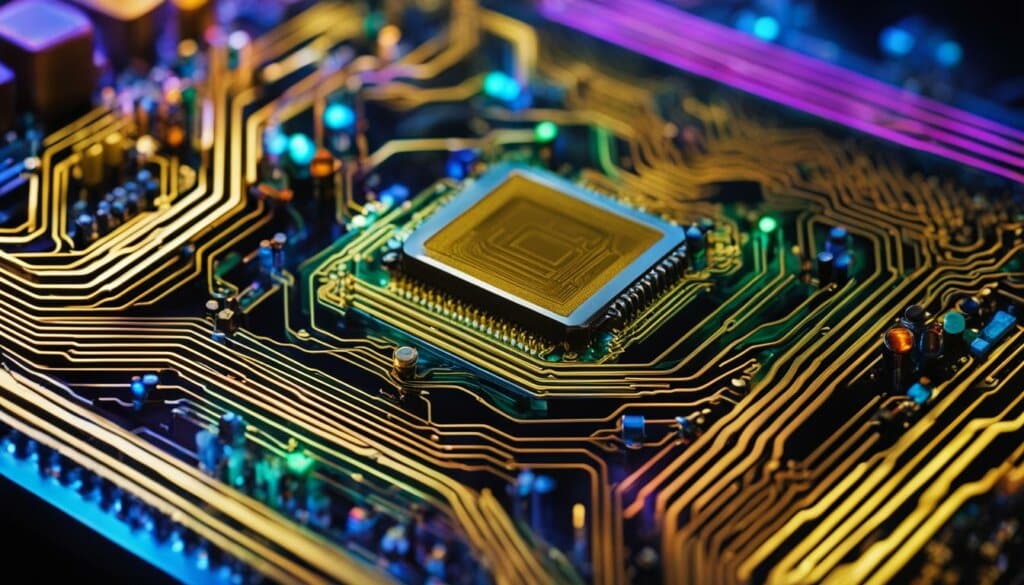
The introduction of microprocessors, such as Intel’s groundbreaking 4004, marked a significant milestone in the evolution of processors. These microprocessors integrated the entire CPU onto a single chip, democratizing computing and making it accessible to the masses. The compact size and affordability of microprocessors opened up new possibilities for applications in various industries, ranging from personal computers to industrial automation.
The advent of microprocessors also led to rapid advancements in processor architecture and performance. With each new generation, microprocessors witnessed an increase in clock speed, the number of transistors, and instructions per second. This continuous progress fueled the growth of the semiconductor industry, enabling the development of more powerful and capable processors.
The Impact of Integrated Circuits and Microprocessors
The introduction of integrated circuits and microprocessors had a profound impact on various aspects of society and technology. Here are some key contributions:
- Computing Accessibility: The development of microprocessors made computing technology more accessible to individuals and businesses, revolutionizing the way people work, communicate, and access information.
- Miniaturization and Portability: The compact size of microprocessors allowed for the development of smaller, portable computing devices, leading to the proliferation of laptops, smartphones, and other mobile devices.
- Increased Processing Power: Microprocessors enabled an exponential increase in computing power, facilitating complex calculations and data processing tasks that were previously unimaginable. This advancement laid the foundation for numerous technological breakthroughs in fields like artificial intelligence, data analytics, and scientific research.
- Advancements in Automation: The integration of microprocessors into industrial systems and machinery revolutionized automation, improving efficiency, accuracy, and productivity across various industries, ranging from manufacturing to healthcare.
The advent of integrated circuits and microprocessors marked a crucial turning point in the evolution of processors. The compactness, affordability, and increased computing power offered by these innovations paved the way for the digital revolution, transforming the world as we know it.
| Year | Key Development |
|---|---|
| 1971 | Intel introduces the world’s first microprocessor, the Intel 4004. |
| 1974 | Intel releases the 8080 microprocessor, which becomes the foundation for the personal computer revolution. |
| 1978 | Intel launches the 8086 microprocessor, setting the standard for the x86 architecture that dominates the industry. |
| 1981 | IBM introduces the IBM PC, which utilizes Intel’s 8088 microprocessor. |
| 1985 | Intel releases the 80386 microprocessor, the first 32-bit processor, significantly enhancing computing capabilities. |
Parallel Processing and the Era of Multi-Core Systems (2000s – 2010s)
In the 2000s and 2010s, the evolution of processors witnessed a significant shift in architecture and innovation with the introduction of multi-core systems. These processors integrated multiple cores on a single chip, enhancing performance and efficiency in various computing tasks. Multi-core processors enabled computers to handle multitasking with ease, allowing users to run multiple applications simultaneously without compromising speed or performance.
The adoption of multi-core processors brought several advantages, including enhanced performance and increased energy efficiency. By having multiple cores working together, each core could focus on specific tasks, resulting in faster processing times and improved overall system performance. Additionally, the introduction of multi-core systems contributed to a significant reduction in power consumption, addressing the growing concern of energy efficiency in computing technologies.
With the emergence of multi-core processors, a paradigm shift occurred in processor architecture. Software developers had to adapt their programs to take advantage of the multi-core capabilities, distributing tasks efficiently across the available cores. This shift led to innovations in programming languages and development frameworks, enabling the creation of applications that could harness the full potential of multi-core processing.
Overall, the era of multi-core systems marked a milestone in the evolution of processors, offering enhanced performance, improved energy efficiency, and the ability to handle complex multitasking. This innovation opened up new possibilities in various industries, including gaming, scientific research, data analysis, and artificial intelligence, driving advancements in computing technologies and shaping the future of processors.
Advantages of Multi-Core Processors:
- Enhanced performance and faster processing times
- Improved energy efficiency and reduced power consumption
- Ability to handle complex multitasking and run multiple applications simultaneously
- Increased productivity and efficiency in various computing tasks
- Support for parallel processing, enabling faster data analysis and simulations
Challenges and Innovations in Multi-Core Processor Development:
- Software optimization to fully utilize multi-core capabilities
- Efficient task scheduling and load balancing across cores
- Addressing potential bottlenecks and synchronization issues
- Advancements in heat dissipation and thermal management
- Integration of specialized cores for specific tasks such as graphics processing and machine learning
| Processor | Release Year | Number of Cores | Manufacturing Process |
|---|---|---|---|
| Intel Core i7-8700K | 2017 | 6 | 14nm |
| AMD Ryzen 9 5950X | 2020 | 16 | 7nm |
| Apple M1 | 2020 | 8 | 5nm |
Quantum Computing: The Frontier of Processing Power

Quantum computing is a groundbreaking field that holds immense promise for the future of processors. Unlike classical processors that are based on binary bits, quantum processors utilize quantum bits, or qubits, which can represent both 0 and 1 simultaneously. This unique property allows quantum computers to process vast amounts of information in parallel, enabling them to solve complex problems that are beyond the capabilities of classical computers.
One of the key advantages of quantum computing lies in its processing capabilities. Quantum computers have the potential to solve computationally intensive tasks, such as cryptography and material science, at an unprecedented speed. For example, quantum computers can effectively break complex encryption algorithms, posing both opportunities and challenges for data security.
Cryptography is one of the areas where quantum computing is expected to have a significant impact. Quantum computers can perform calculations that would take classical computers millions of years to complete. This poses a threat to current encryption methods, which rely on the difficulty of solving certain mathematical problems. As a result, researchers are working on developing quantum-resistant encryption techniques to ensure the security of data in the post-quantum era.
| Application | Advantages | Disadvantages |
|---|---|---|
| Cryptography | – Break complex encryption algorithms – Enhance data security |
– Threat to current encryption methods – Development of quantum-resistant encryption techniques required |
| Material Science | – Simulate atomic and molecular interactions – Accelerate discovery of new materials |
– Complex calculations required for accurate simulations – Limited number of qubits available |
Quantum computing represents a fundamental shift in the way we process information. Its potential to revolutionize fields like cryptography and material science is both exciting and challenging. As we explore the possibilities of quantum computing, we must also address the limitations and develop solutions to the unique computational problems it presents.
Material Science: Accelerating Discoveries through Simulations
Another area where quantum computing shows great promise is material science. With the ability to simulate atomic and molecular interactions on a quantum scale, quantum computers can accelerate the discovery of new materials with extraordinary properties. This has the potential to revolutionize industries such as energy, electronics, and healthcare.
However, there are challenges in utilizing quantum computing for material science. Accurate simulations require complex calculations that demand a large number of qubits. Currently, qubit technology is still in its early stages, with limited numbers available. Researchers are working towards developing more stable and scalable qubits to overcome this limitation and unlock the full potential of quantum computing in material science applications.
The field of quantum computing is still in its infancy, but it holds tremendous potential for the future of processors. From solving complex problems in cryptography to accelerating discoveries in material science, quantum computing opens up new frontiers in processing power. As we continue to explore and develop this exciting field, we must overcome the challenges and work towards harnessing the full capabilities of quantum processors.
Neuromorphic and Biological Computing
Neuromorphic computing and biological computing are emerging fields that hold great promise in the realm of artificial intelligence and machine learning. These innovative approaches seek to unlock new levels of computational power by drawing inspiration from the human brain and biological processes. While they offer unique advantages, they also present their own sets of challenges and considerations.
Neuromorphic computing aims to replicate the structure and operations of the human brain in silicon form. By mimicking the architecture of the brain, neuromorphic processors have the potential to process massive amounts of data in parallel, enabling advanced capabilities in artificial intelligence and machine learning. These processors excel at tasks like pattern recognition, natural language processing, and complex decision-making. The key advantage of neuromorphic computing is its ability to perform these tasks with significantly lower power consumption compared to traditional computing architectures.
On the other hand, biological computing explores the use of living cells, particularly DNA, as computational devices. This field leverages the remarkable capabilities of biological systems to perform complex calculations and computations. By harnessing the inherent parallelism and information processing abilities of DNA, biological computing offers a unique approach to solving complex problems. Additionally, biological computing shows potential in areas such as healthcare, where it could enable personalized medicine and targeted therapies.
While neuromorphic and biological computing have tremendous potential, they also present challenges. For neuromorphic computing, scaling up the technology and achieving high-fidelity replication of the brain’s complexity remains a significant hurdle. Additionally, ensuring the ethical use and responsible development of artificial intelligence and machine learning systems powered by these technologies is of utmost importance. In the case of biological computing, the integration of biological components into computing systems raises questions around safety, biosecurity, and the potential for unintended consequences.
In conclusion, neuromorphic and biological computing represent cutting-edge approaches to unlocking new frontiers in artificial intelligence and machine learning. As these fields continue to evolve, researchers and developers must address technical challenges and consider ethical implications. Both neuromorphic and biological computing offer exciting possibilities for the future of processors and their applications in a wide range of industries.
Evolution of Processor Sizes and Performance
The evolution of processors is not only defined by their architectural advancements but also by their sizes and performance capabilities. Over the years, processors have become smaller, more powerful, and more efficient, enabling advancements in various industries and transforming the way we live and work.
One of the key factors that determine the performance of a processor is its clock speed, which refers to the number of cycles per second at which a processor can execute instructions. Higher clock speeds generally result in faster processing of data and improved overall performance.
Another important metric in processor development is the number of transistors. Transistors are the building blocks of processors, and increasing their number allows for more complex computations and greater processing power. With each new generation of processors, the number of transistors has significantly increased, leading to exponential growth in computing capabilities.
Instructions per second (IPS) is a measure of a processor’s ability to execute instructions within a given time frame. As processors have evolved, the IPS has also improved, allowing for faster and more efficient data processing. This has led to advancements in areas such as artificial intelligence, big data analytics, and scientific simulations.
| Processor Generation | Clock Speed (GHz) | Number of Transistors | Instructions per Second (IPS) |
|---|---|---|---|
| First Generation | 0.74 | 2,300 | 200,000 |
| Tenth Generation | 5.30 | 10,000,000,000 | 50,000,000,000 |
| Twenty-Third Generation | 10.20 | 50,000,000,000,000 | 500,000,000,000,000 |
In summary, the evolution of processor sizes and performance has been driven by advancements in clock speed, the number of transistors, and instructions per second. As processors continue to evolve, we can expect further improvements in these areas, leading to even more powerful and efficient computing systems.
Generations of Microprocessors
Microprocessors have gone through several generations of development, each bringing significant advancements in terms of architecture and performance. These generations mark key milestones in the evolution of microprocessors, shaping the landscape of modern computing. Let’s take a closer look at each generation:
First Generation (1971 – 1972)
The first-generation microprocessor was the Intel 4004, introduced in 1971. It was a 4-bit processor that revolutionized the industry by integrating the entire central processing unit (CPU) on a single chip. While limited in terms of performance, the Intel 4004 laid the foundation for future advancements in microprocessor technology.
Second Generation (1973 – 1978)
The second generation of microprocessors saw the development of 8-bit processors, which offered improved performance and expanded capabilities. Notable processors from this generation include the Intel 8008, Intel 8080, and Motorola 6800. These processors played a crucial role in the early development of personal computers and brought computing power to a wider audience.
Third Generation (1979 – 1985)
The third generation marked the introduction of 16-bit processors, which further enhanced performance and opened up new possibilities for computing. The Intel 8086 and Intel 8088 processors were among the most influential processors of this generation, powering early personal computers and paving the way for the IBM PC.
Fourth Generation (1985 – 1995)
The fourth generation saw a significant leap in processing power with the introduction of 32-bit processors. These processors, such as the Intel 80386 and Motorola 68040, offered improved performance and expanded memory capabilities. The fourth generation also witnessed the rise of RISC (Reduced Instruction Set Computing) processors, which focused on efficiency and faster execution.
Fifth Generation (1995 – Present)
The fifth generation of microprocessors brought 64-bit processing to the mainstream. Processors like the Intel Pentium 4 and AMD Athlon 64 introduced 64-bit architecture, enabling computers to handle larger amounts of memory and perform more complex calculations. This generation also saw the rise of multi-core processors, which allowed for parallel processing and improved multitasking capabilities.
| Generation | Year | Key Features |
|---|---|---|
| First Generation | 1971 – 1972 | Introduction of Intel 4004, the first microprocessor |
| Second Generation | 1973 – 1978 | Development of 8-bit processors (Intel 8008, Intel 8080, Motorola 6800) |
| Third Generation | 1979 – 1985 | Introduction of 16-bit processors (Intel 8086, Intel 8088) |
| Fourth Generation | 1985 – 1995 | Advancements in 32-bit processors and rise of RISC architecture |
| Fifth Generation | 1995 – Present | Introduction of 64-bit processors and multi-core architecture |
As technology continues to evolve, we can expect further advancements in microprocessor design and capabilities. These generations serve as a testament to the rapid pace of innovation in the semiconductor industry, driving the growth of computing power and enabling new possibilities in various fields.

Types of Microprocessors
Microprocessors come in various types, each designed for specific purposes. Understanding the different types of microprocessors can help in choosing the right one for specific applications. Some of the main types of microprocessors include:
Complex Instruction Set Microprocessor (CISC)
The Complex Instruction Set Microprocessor is designed to perform complex mathematical calculations and handle a wide range of instructions. It focuses on minimizing the number of instructions per program. The CISC microprocessor can execute multi-step operations with a single instruction, making it suitable for applications that require extensive computational capabilities. It is commonly used in desktop computers, servers, and high-performance systems.
Reduced Instruction Set Microprocessor (RISC)
The Reduced Instruction Set Microprocessor emphasizes efficiency and simplicity. It utilizes a simplified instruction set, which allows for faster execution of instructions. The RISC microprocessor is commonly used in embedded systems, mobile devices, and other applications where power efficiency and fast execution are essential. It is also well-suited for applications that involve real-time processing and control.
Superscalar Microprocessor
The Superscalar Microprocessor is designed for parallel processing. It can execute multiple instructions simultaneously, increasing overall performance and throughput. The superscalar microprocessor achieves this by incorporating multiple execution units and a sophisticated instruction dispatch mechanism. It is commonly used in high-performance computing, multimedia applications, and modern processor architectures.
Application-Specific Integrated Circuit (ASIC)
The Application-Specific Integrated Circuit is a microprocessor that is customized for a specific application. It is designed to perform a particular function or set of functions with high efficiency and optimized performance. ASICs are commonly used in specialized applications such as automotive electronics, telecommunications, and consumer electronics. They offer superior performance and power efficiency compared to general-purpose microprocessors.
Digital Signal Processor (DSP)
The Digital Signal Processor is optimized for processing digital signals, such as audio and video data. It is designed to handle specialized mathematical calculations required for signal processing applications. DSPs are commonly used in audio and video processing systems, telecommunications, and multimedia applications. They offer high-speed processing capabilities and are capable of executing complex algorithms in real-time.
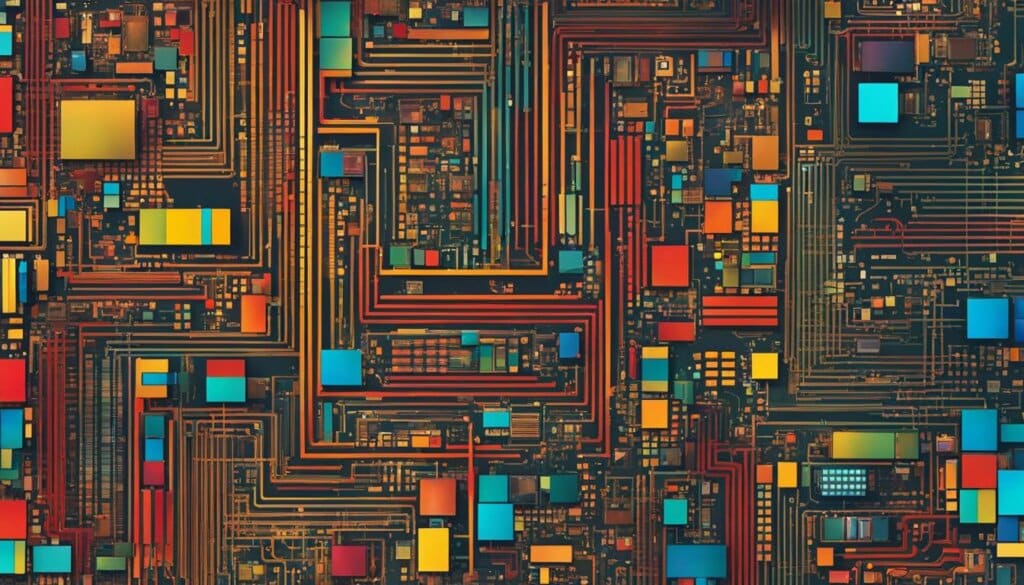
| Type of Microprocessor | Main Features | Common Applications |
|---|---|---|
| Complex Instruction Set Microprocessor (CISC) | Handles complex instructions, extensive computational capabilities | Desktop computers, servers, high-performance systems |
| Reduced Instruction Set Microprocessor (RISC) | Efficient and fast execution, power efficiency | Embedded systems, mobile devices, real-time processing |
| Superscalar Microprocessor | Parallel processing, multiple instructions executed simultaneously | High-performance computing, multimedia applications |
| Application-Specific Integrated Circuit (ASIC) | Customized for specific applications, optimized performance | Automotive electronics, telecommunications, consumer electronics |
| Digital Signal Processor (DSP) | Specialized for signal processing, high-speed processing | Audio and video processing systems, telecommunications, multimedia applications |
Features of Modern Processors
Modern processors have evolved to incorporate a wide range of advanced features, enhancing their performance and capabilities in various applications. These features, combined with the relentless pursuit of technological advancement, have revolutionized the computing landscape.
Clock Speed
One of the key features of modern processors is clock speed, which determines the number of instructions a processor can execute per second. Higher clock speeds result in faster processing times, leading to improved overall performance. Processors with higher clock speeds can handle more demanding tasks and deliver enhanced user experiences.
Instruction Set Architecture
The instruction set architecture (ISA) defines the set of instructions that a processor can execute. There are two main types of ISAs: Complex Instruction Set Computers (CISC) and Reduced Instruction Set Computers (RISC). CISC processors can execute complex instructions, while RISC processors focus on simpler instructions for faster execution. The choice of ISA depends on the specific requirements of the application or system.
Cache Memory
Cache memory is a small, high-speed memory that stores frequently accessed data to minimize the time taken to fetch data from the main memory. It plays a crucial role in improving processor performance by reducing memory latency. Processors with larger cache sizes can store more data, resulting in faster access times and improved overall system performance.
Multi-Core Processors
Modern processors often feature multiple cores, allowing for parallel processing and improved multitasking capabilities. Each core can independently execute instructions, enabling the processor to handle multiple tasks simultaneously. Multi-core processors provide significant performance benefits, especially for applications that can utilize parallel processing effectively.
Virtualization
Virtualization technology enables the creation of virtual machines (VMs) that can run multiple operating systems on a single physical processor. This allows for efficient resource allocation, improved system utilization, and simplified management of software applications. Virtualization has become an essential feature for server environments and cloud computing, enabling cost-effective and flexible deployments.
Power Management
Power management features play a vital role in modern processors, as they help optimize power consumption and improve energy efficiency. Processors incorporate various techniques, such as frequency scaling and voltage regulation, to reduce power consumption during idle periods and dynamically adjust performance levels based on workload requirements. Effective power management extends battery life in mobile devices and reduces operating costs in data centers.
Graphics Processing
Integrated graphics processing units (GPUs) have become a standard feature in modern processors, offering high-performance graphical capabilities without the need for a separate graphics card. GPUs enhance the visual experience in gaming, multimedia applications, and content creation. They can also accelerate certain computational tasks, such as machine learning and scientific simulations.
Security Features
Modern processors incorporate various security features to protect against software vulnerabilities and malicious attacks. These features include secure booting, data encryption, and hardware-based secure enclaves. Processors with robust security features help safeguard sensitive data and ensure the integrity of software applications.
Internet Connectivity
Internet connectivity has become a fundamental requirement for modern processors. Processors are equipped with integrated network interfaces, allowing for seamless connectivity to the internet and local networks. This enables a wide range of applications, including online gaming, video streaming, and cloud-based services.
Machine Learning Capabilities
With the rise of artificial intelligence and machine learning, modern processors are increasingly incorporating specialized hardware accelerators to improve performance in these workloads. These accelerators, such as tensor processing units (TPUs), are designed to handle the complex computations required for machine learning tasks. Processors with dedicated machine learning capabilities offer significant performance benefits in areas such as image recognition, natural language processing, and predictive analytics.
In conclusion, modern processors have evolved to incorporate a wide range of features that enhance their performance and capabilities. From clock speed and instruction set architecture to cache memory and multi-core processing, these features contribute to improved overall system performance, energy efficiency, and connectivity. As technology advances, processors will continue to push the boundaries, enabling new and innovative applications in various fields.

Advantages of Microprocessors
Microprocessors offer a wide range of advantages that have made them an integral part of modern computing. These advantages contribute to their popularity and widespread use in various industries. Here are some key benefits of microprocessors:
- High Processing Speed: One of the significant advantages of microprocessors is their ability to perform computations at incredibly high speeds. The design and architecture of microprocessors enable them to execute instructions quickly, allowing for swift data processing and efficient task completion.
- Compact Size: Microprocessors are small and compact in size, making them ideal for integration into various devices and systems. Their small form factor enables the creation of sleek and portable devices, from smartphones and tablets to wearable technology and Internet of Things (IoT) devices.
- Easy Maintenance: Microprocessors are designed with simplicity in mind, making them easy to maintain and troubleshoot. Their modular design allows for easy replacement and upgrading, minimizing downtime and reducing maintenance costs.
- Complex Mathematics: Microprocessors have the capability to perform complex mathematical calculations efficiently. This feature is crucial in various fields such as scientific research, engineering, financial analysis, and artificial intelligence.
- Flexibility: Microprocessors offer great flexibility in terms of programming and customization. They can be programmed to execute specific tasks, allowing for the development of specialized software and applications tailored to unique requirements.
- Improvements According to Requirements: Microprocessors can be continuously improved and upgraded to meet evolving technological needs. Manufacturers regularly release new generations of microprocessors with enhanced performance, additional features, and improved energy efficiency, ensuring that the capabilities of microprocessors keep pace with the demands of modern computing.
These advantages make microprocessors indispensable in the digital age, powering a wide range of devices and systems that drive innovation and shape our daily lives.
Disadvantages of Microprocessors
While microprocessors have revolutionized the world of computing, they are not without their drawbacks. Understanding these disadvantages is crucial in order to make informed decisions and address the challenges that arise from using microprocessors.
One significant disadvantage is the issue of overheating. Microprocessors generate heat during operation, and if not properly managed, this can lead to performance issues and even permanent damage to the processor. Overheating can occur when the processor is under heavy load or when the cooling system is insufficient. Efficient heat management is essential to maintain the longevity and optimal performance of microprocessors.
Another disadvantage is the performance dependence on the size of the data being processed. Microprocessors have limited memory and cache sizes, which means that large data sets may result in slower processing speeds. This limitation can be mitigated by optimizing algorithms and utilizing external memory resources, but it remains a challenge when dealing with computationally intensive tasks.
In addition, microprocessors often require larger board sizes compared to microcontrollers. This can have implications for space-constrained applications, where the size of the processor is a critical factor. The larger board sizes can also increase production costs and restrict the flexibility of system designs.
Furthermore, microprocessors have limited support for floating-point operations compared to specialized processors. Floating-point operations are commonly used in scientific and graphics-intensive applications. While floating-point operations can still be performed on microprocessors, their performance may not match that of dedicated floating-point processors.
Despite these disadvantages, microprocessors continue to be the backbone of modern computing, powering a wide range of devices and applications. The key lies in understanding these limitations and finding creative solutions to optimize their performance and address the challenges they present.
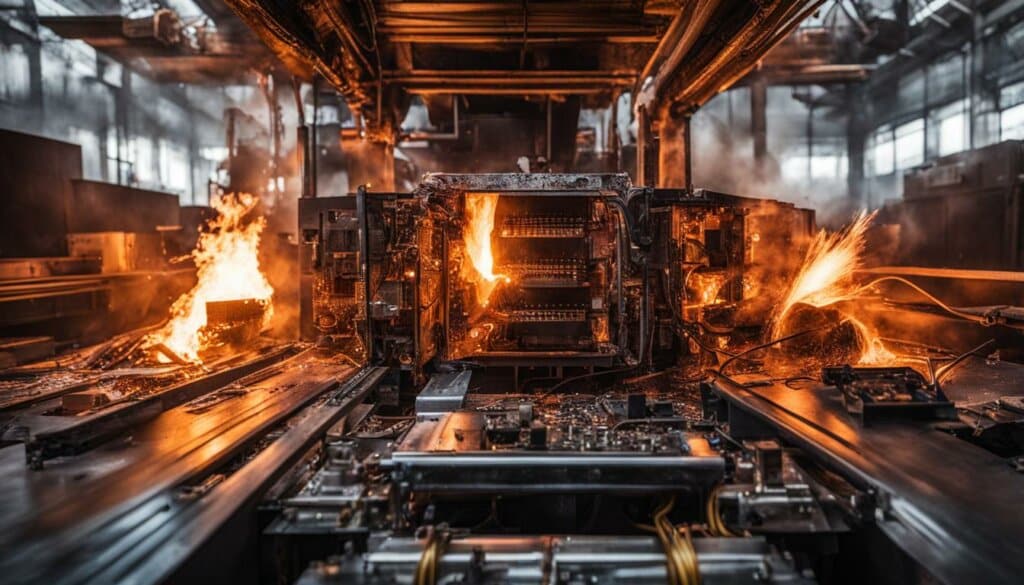
The Challenges of Overheating
Overheating is a significant concern when it comes to microprocessors. As microprocessors continue to evolve and deliver more powerful performance, they generate more heat. This heat can negatively impact the performance and lifespan of the processor, leading to potential system failures.
In order to mitigate the challenges of overheating, manufacturers implement various cooling techniques such as fans, heat sinks, and liquid cooling systems. These cooling solutions help dissipate the heat generated by the microprocessor and maintain optimal operating temperatures. However, in certain situations, such as high-performance computing or overclocking, additional cooling measures may be required to ensure the microprocessor operates within safe temperature limits.
Efficient heat management is essential to prevent thermal throttling, where the processor reduces its clock speed to prevent overheating. Thermal throttling can significantly impact the performance of the system, leading to slower processing and reduced efficiency. By carefully considering the cooling solution and system design, the challenges of overheating can be effectively addressed, ensuring the smooth operation of microprocessors in various computing applications.
Performance Dependence on Data Size
Microprocessors excel at processing small to medium-sized data sets efficiently. However, their performance can be significantly affected when dealing with large data sets.
As the size of the data being processed increases, microprocessors may encounter memory limitations that result in slower processing speeds. This performance dependence on data size can be a concern in applications that require intensive data processing, such as scientific simulations, big data analytics, and artificial intelligence algorithms.
To overcome this challenge, developers can employ techniques such as data compression, parallel processing, distributed computing, and memory optimization to improve performance. By carefully optimizing algorithms and utilizing external memory resources, the performance of microprocessors can be enhanced even when dealing with large data sets.
Large Board Sizes and Design Flexibility
One disadvantage of microprocessors is their larger board sizes compared to microcontrollers. This can pose challenges in space-constrained applications or systems that require compact designs.
Larger board sizes can limit the flexibility of system designs and increase production costs. In cases where size and weight are critical factors, microcontrollers or specialized processors may be more suitable alternatives.
The size of the microprocessor board can impact the overall form factor and functionality of the system. It is crucial for designers to carefully consider the size and requirements of the microprocessor when designing compact and portable devices.
Limited Support for Floating-Point Operations
Microprocessors have limited support for floating-point operations, which are essential for calculations involving decimal numbers, scientific simulations, and graphics-intensive applications.
While microprocessors can perform basic floating-point operations, they may not match the performance of specialized processors specifically designed for floating-point calculations. For applications that heavily rely on floating-point operations, alternatives such as graphics processing units (GPUs) or field-programmable gate arrays (FPGAs) may provide better performance.
Despite these limitations, microprocessors remain a versatile and widely used solution for a wide range of applications. By understanding their limitations and selecting the appropriate tools and optimizations, developers can overcome these challenges and leverage the power of microprocessors in their projects.
| Disadvantage | Description |
|---|---|
| Overheating | Microprocessors generate heat during operation, which can affect performance and lifespan if not properly managed. |
| Performance Dependence on Data Size | Microprocessors may experience slower processing speeds when dealing with large data sets. |
| Large Board Sizes | Microprocessors typically require larger board sizes compared to microcontrollers, which can limit system design flexibility. |
| Limited Support for Floating-Point Operations | Microprocessors may have limited performance when it comes to floating-point calculations, compared to specialized processors. |
The Changing Landscape of Processors: Competition and Roadmaps
The world of processors is a dynamic and fiercely competitive landscape, with major players like Intel and AMD constantly pushing the boundaries of innovation. These industry leaders engage in a continuous battle to develop cutting-edge technologies that cater to the evolving needs of x86 users and stay ahead of the competition from Arm licensees.
Both Intel and AMD regularly tease upcoming products to generate excitement and keep their customers eagerly waiting for the next breakthrough. Intel, for instance, has a robust roadmap that includes their data center strategy, with processors like Ice Lake based on the Sunny Cove microarchitecture. Similarly, AMD is focusing on its Zen 3 cores, which will be featured in their Epyc server processors.
To provide transparency and guidance to their customer base, both Intel and AMD share their future roadmap updates. These roadmaps outline the planned enhancements, improvements, and innovations that users can expect in the coming years. By doing so, these companies not only inspire confidence but also enable businesses to align their strategies with the upcoming developments in the processor market.
Table:
| Company | Roadmap Highlights |
|---|---|
| Intel | Ice Lake processors based on Sunny Cove microarchitecture |
| AMD | Zen 3 cores in Epyc server processors |

Conclusion
The journey of processor evolution is a testament to human potential and our unyielding quest for technological advancements. From the early stages of computing to the groundbreaking realms of quantum and biological computing, processors have continuously pushed the boundaries, transforming society and driving innovation.
The future of processors holds immense promise, with paradigm shifts and advancements that could redefine the very nature of computation. As we embark on this exciting path, it is crucial to consider the ethical implications that arise with increasingly advanced processors. Striking a balance between progress and responsibility will be vital to ensure the positive impact of these technological advancements on society.
The processor evolution timeline is far from complete, with endless possibilities awaiting exploration. It is our boundless ingenuity and curiosity that will fuel further breakthroughs, unlocking new frontiers and expanding the horizons of human achievement. As we embark on this journey into the future, let us embrace the potential of processors to shape a better world for all.
FAQ
What were the early computer processors like?
The early computer processors used vacuum tubes and relays, which were energy-intensive and prone to breakdowns.
How did the invention of transistors revolutionize processors?
Transistors replaced vacuum tubes, offering compactness, energy efficiency, and reliability, paving the way for further advancements in processor design and capability.
What were the groundbreaking developments in processor technology in the 1970s and 1980s?
The invention of integrated circuits led to the birth of microprocessors, such as Intel’s 4004, which integrated a complete CPU on a single chip, making computing accessible to the masses.
What are multi-core processors?
Multi-core processors integrate multiple processor cores on a single chip, allowing computers to handle multiple tasks simultaneously and addressing challenges of power consumption and efficiency.
What is quantum computing?
Quantum computing utilizes qubits, which can represent both 0 and 1 simultaneously, allowing quantum computers to process vast amounts of information concurrently and solve complex problems in fields like cryptography and material science.
What is neuromorphic computing?
Neuromorphic computing seeks to replicate the structure and operations of the human brain in silicon form, enabling advanced artificial intelligence and machine learning systems.
How have processors evolved in terms of size and performance?
Each generation of microprocessors has witnessed improvements in clock speed, the number of transistors, and instructions per second, contributing to the growth of the semiconductor industry and the increasing power and capabilities of modern processors.
What are the different generations of microprocessors?
Microprocessors can be categorized into different generations based on the time period and the advancements introduced, such as the first generation with pioneering microprocessors like Intel 4004, and subsequent generations with 8-bit, 16-bit, 32-bit, and 64-bit processors.
What are the types of microprocessors?
Microprocessors come in various types, including complex instruction set microprocessors, reduced instruction set microprocessors, superscalar microprocessors, application-specific integrated circuits, and digital signal multiprocessors, serving specific purposes and applications.
What features do modern processors have?
Modern processors encompass features like clock speed, instruction set architecture, cache memory, multi-core processing, virtualization, power management, integrated graphics processing, security features, internet connectivity, and specialized processing units for machine learning tasks.
What are the advantages of microprocessors?
Microprocessors offer advantages such as high processing speed, compact size, ease of maintenance, the ability to perform complex mathematical calculations, flexibility in design, and the ability to be improved according to specific requirements.
What are the disadvantages of microprocessors?
Disadvantages of microprocessors include issues with overheating, performance dependence on the size of data being processed, larger board sizes compared to microcontrollers, and limited support for floating-point operations.
How is competition shaping the evolution of processors?
Major players like Intel and AMD continually release product updates and roadmaps to stay ahead in the market, ensuring competition and providing options for users.
Source Links
- https://www.techtarget.com/searchdatacenter/feature/Explore-the-evolution-of-Intel-and-AMD-server-processors
- https://pcsite.medium.com/the-evolution-of-computer-processors-a-historical-overview-6d19ca3620d8
- https://www.geeksforgeeks.org/evolution-of-microprocessors/

